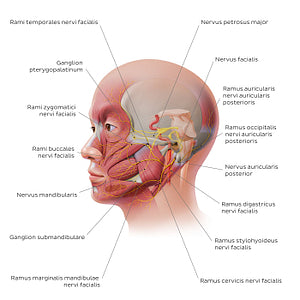Paul Kim
Facial nerve: extracranial branches (Latin)
Facial nerve: extracranial branches (Latin)
After it emerges from the foramen stylomastoideum, the n. facialis gives off the n. auricularis posterior (which provides motor innervation to the occipital part of occipitofrontalis muscle and auricular muscles, as well as sensory innervation to variable amounts of the auricle and regio retroauricularis), as well as other motor branches to the m. digastricus (venter posterior) and m. stylohyoideus. It then enters the gl. parotidea and bifurcates into two trunks, which give off five terminal branches collectively known as the plexus parotideus. These are the rr. temporales, rr. zygomatici, rr. buccales, r. mandibularis marginalis]';, and r. cervicalis, all of which innervate the muscles of facial expression but do not innervate the gl. parotidea itself.
Regular price
$7.56 USD
Regular price
Sale price
$7.56 USD
Unit price
per
Couldn't load pickup availability


#CB3632
#A75C62
#63221E
#5E412F
#E0A398
#D0B6AE

